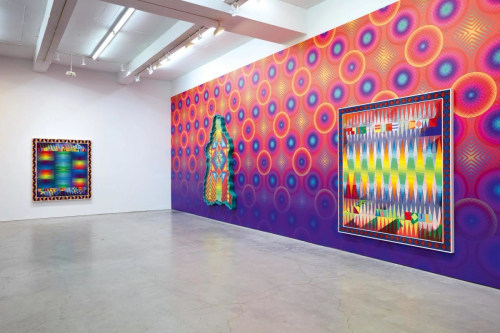

By Carlie Porterfield
Jeffrey Gibson is representing the US at this year’s Venice Biennale, marking the first time the country has staged a solo exhibition by an Indigenous artist. Gibson, who is a member of the Mississippi Band of Choctaw Indians and is also of Cherokee descent, was born in Colorado and moved frequently growing up, living across the US as well as abroad, including in Germany and South Korea. This international upbringing influenced Gibson’s colourful work, which often incorporates Native American traditions with text, a variety of textiles and concepts like identity and globalism.
How are you approaching the idea of representing the US, given the country’s history of massacres, displacement and racism? How are you thinking about your presentation in relation to that history?
It was very daunting initially. My initial proposal was very different from what I ultimately decided to do. I went to Venice [in 2022] and I realised the kind of weight and pressure of representing the US, and I started thinking about what I felt was important for me to contribute, content-wise, to that.
Ultimately, it came down to looking at my practice and thinking about the things that have been the most impactful with audiences. Some of it is where people see themselves in the work, in particular Native people and Indigenous people. In Native communities, many people refer to their nations, like the Choctaw Nation. Words like “nationhood” and “homeland” become complicated when I’m representing the US. I also had to be really honest with myself that throughout my life growing up abroad, I have identified as American, and then talked about being Native American in places where some people were really unfamiliar with it. I felt like it was my responsibility to just tell my story.
The title of the pavilion is the space in which to place me. Can you share what drew you to this passage from Layli Long Soldier’s poem He Sápa?
I have followed Layli’s work for years now, and it speaks to me on a personal level. She is able to put into words and lay onto a page the internal thoughts I’ve had my whole life. When I was thinking about a title, I knew that I wanted to work with an Indigenous writer.
The text goes, “This is how you see me the space in which to place me/The space in me you see is this place/To see this space see how you place me in you”. That piece does what I try to accomplish with the way that I use text, which is always hoping that people can project themselves and their own stories into it in a way that becomes self-reflective. That’s one of the goals of the pavilion. Although I am Indigenous, I hope that we’re not just looked at as [having] a kind of separate experience, but more as individuals who have experiences that can overlap with people from many different nationalities and many different backgrounds.
What kind of themes does the pavilion explore?
I wanted to start by reading the foundational documents of the US. I started with the Bill of Rights and the Declaration of Independence, and eventually that led me to things like amendments and proposals that have yet to be passed or may never be passed. You get into individuals who were parts of those movements and statements that they’ve made. There are a little over 20 works in the exhibition. It is a wonderful way for me to walk through history and think about my own family and my own tribes and where they’ve existed in the states of the US and in what periods of history.
What do you think are the hallmarks of a successful national pavilion? Have any in particular stuck with you?
Mike Nelson for the British Pavilion [I, Imposter in 2011]. It was like you were in a weird headspace. You just couldn’t make sense of it. I felt like it was a real, very immersive experience that I wanted to return to. I also remember seeing Félix González-Torres’s installation in the American pavilion [Americain, 2007]. I’m a huge fan, he’s been a huge influence on me.
I think a strong pavilion for me is when the space is addressed, and it doesn’t feel like we’ve tried to recreate a white box institutional space, and the building itself is sculpturally important. For me, the American pavilion is a fully activated space. This is the building you inherit if you’re going to represent the US.
The American pavilion didn’t come into the Biennale until 1930, so I think it’s interesting that the architecture is very much marked by the period it was commissioned, and that was a very significant period for Native people as well. There are very few things that don’t carry a ton of content with them, including the building itself.
Image: Jeffrey Gibson, Ancestral Superbloom, 2023. Photo by Jason Wyche